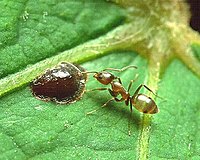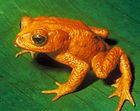Ecological extinction
Ecological extinction is "the reduction of a species to such low abundance that, although it is still present in the community, it no longer interacts significantly with other species".[1]
Ecological extinction stands out because it is the interaction ecology of a species that is important for conservation work. They state that "unless the species interacts significantly with other species in the community (e.g. it is an important
This view stems from the neutral model of communities that assumes there is little to no interaction within species unless otherwise proven.
Estes, Duggins, and Rathburn (1989) recognize two other distinct types of extinction:
- Global extinction is defined as "the ubiquitous disappearance of a species".[1]
- Local extinction is characterized by "the disappearance of a species from part of its natural range".[1]
Keystone species

Examples

The potential role of the
The California spiny lobster, or Panulirus interruptus, is a keystone predator that has a distinct role in maintaining species diversity in its habitat. Robles (1987) demonstrated experimentally that the exclusion of spiny lobsters from the intertidal zone habitats led to the competitive dominance of mussels (Mytilus edulis and M. californianus). This results shows another example of how the ecological extinction of a keystone predator can reduce species diversity in an ecosystem. The threshold of ecological extinction has passed due to over fishing so that local extinctions of the California spiny lobster are common.[4]
Commercial oyster fishing had not affected the Chesapeake Bay ecosystem until mechanical dredges were utilized in the 1870s, resulting in overfishing of the oysters. The bay today is plagued by eutrophication due to algal blooms, and the resulting water is highly hypoxic. These algal blooms have competitively excluded any other species from surviving, including the rich diversity in faunal life that once flourished such as dolphins, manatees, river otters, sea turtles, alligators, sharks, and rays. This highlights the top-down loss of diversity commercial fishing has on marine ecosystems by removing the keystone species of the environment.[5]
Invasive species
The potential ecological extinction of

Seed dispersal mechanisms play a fundamental role in the regeneration and continuation of community structure, and a recent study by Christian (2001) demonstrated a shift in the composition of the plant community in the South African shrublands following an invasion by the Argentine ant (Linepithema humile). Ants disperse up to 30% of the flora in the shrublands and are vital to the survival of fynbos plants because they bury the large seeds away from the dangers of predation and fire damage. It is also crucial for seeds to be buried, because nearly all seed germination takes place in the first season after a fire. Argentine ants, a recent invader, do not disperse even small seeds. Christian tested whether the invasion of the Argentine ant differentially effected small and large-seeded fauna. He found that post-fire recruitment of large-seeded flora was reduced disproportionately for large seeds in sites already invaded by Argentine ants. These initial low large-seed density recruitments will eventually lead the domination of small-seeded fauna in invaded habitats. The consequences of this change in community structure highlight the struggle for dispersal of large-seeded flora that have potential reverberations around the world because ants are major ecological seed dispersers throughout the globe.[7]
Modeling ecological extinction

The McConkey and Drake (2006) study is unique because it was one of the first attempts to model a density-dependent threshold relationship that described ecological extinction. They studied a seed dispersal interaction between flying foxes and trees with large seeds on the tropical Pacific Islands. Insular flying foxes (
While ecologists are just starting to get a grapple on the significant interactions within an ecosystem, they must continue to find an effective density threshold that can maintain the level of equilibrium species diversity. Only with this knowledge of where and to what extent a specific species interacts with its environment will the proper and most efficient levels of conservation work take place. This work is especially important on the limited ecosystems of islands, where there are less likely to be replacement species for specific niches. With species diversity and available habitat decreasing rapidly worldwide, identifying the systems that are most crucial to the ecosystem will be the crux of conservation work.[8]
Climate change
Climate change has produced numerous shifts in the distributions and abundances of species. Thomas et al. (2004) went on to assess the extinction risk due to these shifts over a broad range of global habitats. Their predictive model using midline estimates for climate warming over the next 50 years suggests that 15–37% of species will be "committed to extinction" by 2050. Although the average global temperature has risen .6°C, individual populations and habitats will only respond to their local changes in climate.[9] Root et al. (2002) suggests that local changes in climate may account for density changes in regions, shifts in phenology (timing) of events, changes in morphology (biology) (such as body size), and shifts in genetic frequencies. They found that there have been an average phenological shift of 5.1 days earlier in the spring for a broad range of over a thousand compiled studies. This shift was also, as predicted, more pronounced in the upper latitudes that have concurrently had the largest shift in local average temperatures.[10]
While the
Implications for conservation policy
This section may be unbalanced towards certain viewpoints. (January 2017) |
See also
Notes
- ^ a b c d Estes et al. The ecology of extinctions in kelp forest communities Archived 2018-08-07 at the Wayback Machine. Conservation Biology. 3: 252-264. 1989.
- ^ Paine, R. T. The pisaster-tegula interaction: Prey patches, predator food preference, and intertidal community structure[dead link]. Ecology. 6: 950-961. 1969.
- ^ a b Estes et al. Sea otter predation and community organization in the western Aleutian Islands, Alaska. Ecology. 59: 822-833. 1978.
- ^ Robles, C. Predator foraging characteristics and prey population structure on a sheltered shore. Ecology. 65: 1502-1514. 1987.
- ^ Jackson et al. Historical overfishing and the recent collapse of coastal ecosystems. Science. 293(5530): 629-638. 2001.
- ^ .
- ^ Christian, C. E. Consequences of biological invasion the importance of mutualism for plant communities. Nature. 413: 635-640. 2001.
- ^ a b McConkey, K. R., & Drake, D. R. Flying foxes cease to function as seed dispersers long before they become rare. Ecology. 87(2): 271-276. 2006.
- ^ Thomas et al. Extinction risk from climate change. Nature. 427: 145-149. 2004.
- ^ Root et al. Fingerprints of global warming on wild animals and plants. Nature. 421: 57-60. 2003.
- ^ Nehring, S. Establishment of thermophilic phytoplankton species in the North Sea: biological indicators of climatic changes? ICES Journal of Marine Science. 55: 818-823. 1998.
- ^ a b Soulé et al. Strongly interacting species: conservation policy, management, and ethics. Bioscience. 55(2): 168-176. 2005.

